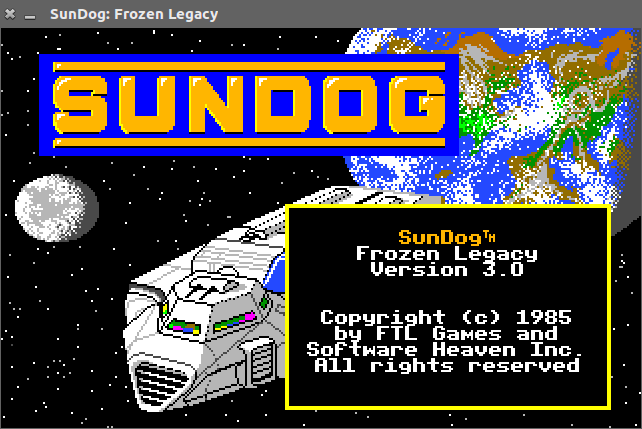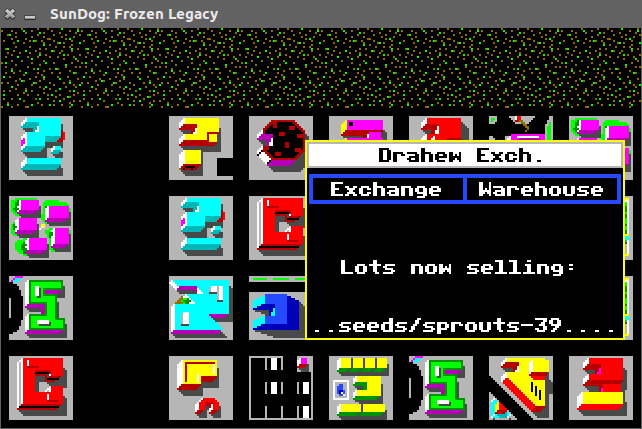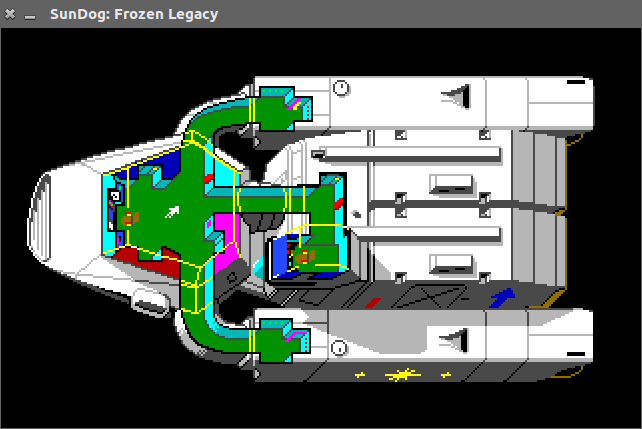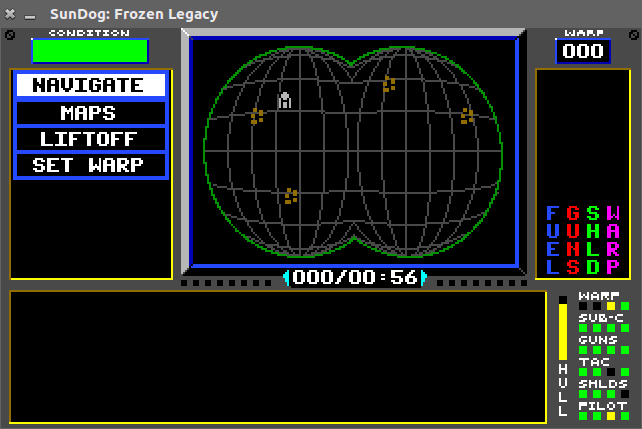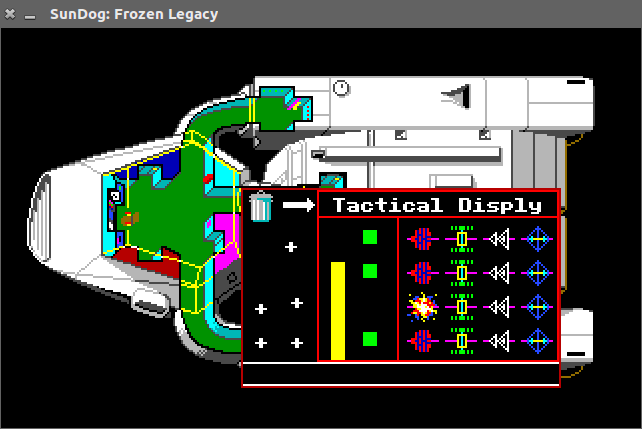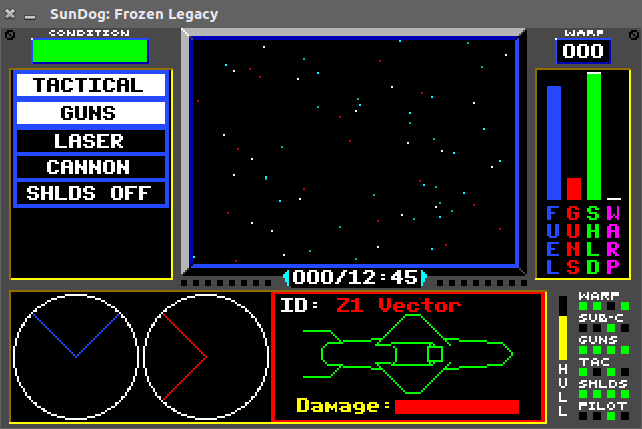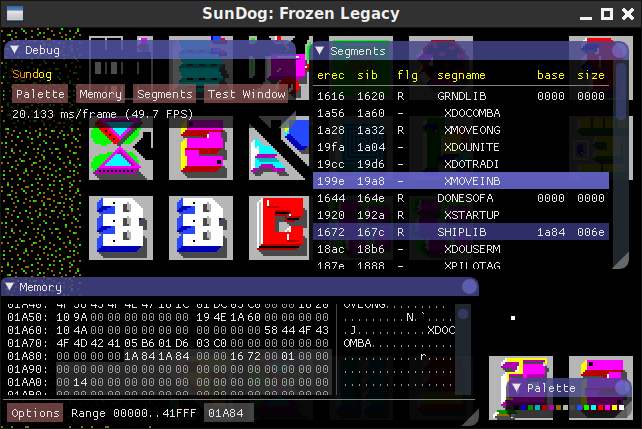This is a port of the Atari ST game SunDog: Frozen Legacy (1985) by FTL software to modern platforms, using SDL2 for input and OpenGL ES 2+ for graphics. A good overview of the gameplay can be found on wikipedia.
The game was originally written in Pascal, developed using the well-known UCSD Pascal compiler. This compiler compiles to bytecode called "p-code" for an abstract architecture called the p-system. This project implements a p-system interpreter (also called "P-Machine Emulator" or PME) in C, which is able to run the game.
This makes it possible to run the game without emulating the Atari ST or even 68000 processor. There are a few assembly-language functions for (primarily) graphics rendering, which have been re-implemented separately.
The goal of this port is to keep the gameplay and graphics close to the Atari ST version, although small hacks or improvements would be welcome. See the Sundog Resurrection project for a complete re-imagining of the game.
For copyright reasons this game does not come with the resources nor game code.
It requires the user to provide a 360K .st raw disk image of the game to run.
This can be imaged from an original copy or found on a dozen abandonware sites.
Be sure to use an image of the original disk: the re-packed version will not
work as the layout of the disk will be different.
Unlike the original game which writes to disk on every start, this implementation never writes to the disk image.
To build from source make sure the SDL2 development package for your distribution is installed, as well as GNU readline (only necessary for the debugger). On Debian and Ubuntu this is:
apt-get install libreadline-dev libsdl2-dev meson ninja-buildThen:
meson setup --buildtype release build
ninja -C build- Install build- and run-time dependencies:
brew install mesa meson ninja sdl2 brew install --cask chromium - Clone this repository
- Create a
gamesubdirectory below the repository, and install your copy of the game asgame/sundog.st - Build from source:
meson setup --buildtype release build -Dbuiltin_image=true ninja -C build - Install the built binary somewhere not in the
PATH(see below), e.g.mkdir /usr/local/lib/sundog cp build/src/sundog /usr/local/lib/sundog/ - Create a shell script
/usr/local/bin/sundogthat readsexport SDL_VIDEO_EGL_DRIVER="/Applications/Chromium.app/Contents/Frameworks/Chromium Framework.framework/Versions/Current/Libraries/libEGL.dylib" exec /usr/local/lib/sundog/sundog "$@" - Run Chromium by hand once, so as to validate the “unknown developer” warning — If you don't, the next step will complain (because the copies of
libEGL.dylibandlibGLESv2.dylibthatsundogattempts to dynamically load, must be whitelisted by the OS before running) - Run
sundogfrom the command line.
The following settings can be set with -Doption=value on the meson command line, or through meson configure:
Project options Default Value Possible Values Description
----------------- ------------- --------------- -----------
builtin_image false [true, false] Use built-in disk image (must be in game/sundog.st)
debug_ui false [true, false] Enable debug user interface
game_cheats false [true, false] Enable cheats
psys_debugger false [true, false] Enable P-system command line debugger
People have built this software for other platforms. It should be pretty straightforward, as we've tried hard to make the source and build system as compatible as possible. Also, SDL2 and support for OpenGL ES 2.0+ (especially when coupled with ANGLE) is widely available.
The CI checks run on Linux (gcc), MacOS (clang) and Windows (MSVC). However, no instructions have been contributed for manual builds on these platforms.
The game can be started using the command line:
build/src/sundog[.exe] [<image.st>]
Where <image.st> is the Sundog disk image to use. If none is provided, it
will look for sundog.st in the same directory as the program. If it isn't
found there, the game will fail to start.
Other options can be provided:
--fullscreen: Make window initially fullscreen.--right-click-emulation: Dedicate the top right corner of the screen to right-click emulation (e.g. for tablets)--no-right-click-emulation: Disable right-click emulation in the top right corner--renderer <renderer>: Set renderer to use:basicis the default, which applies straightforward nearest pixel filtering to scale the image.hq4xis a higher quality pixel art scaler that takes neighbour pixels into account. This is a more expensive algorithm that requires a GPU capable of OpenGL ES 3.0.hqishis another higher quality pixel art scaler. It's different thanhq4xin that it doesn't hardcode a scale factor but computes everything on the fly. This may look better for larger resolutions. YMMV.
--help: Display a help message and exit.
After starting the program the game will immediately start.
Lots of hints for playing the game, as well as the original manual can be found on the excellent Sundog information page.
The game is controlled with the mouse only. There are however some key shortcuts for the interpreter:
sSave state tosundog.savin current directory.lLoad state fromsundog.savin current directory.
Some other shortcuts are debugging related, see debugging.md.
- Loading screen graphics, palette effects.
- Starting a new game.
- Right-click popup in-game.
- Walking around the ship and in buildings.
- Liftoff / Landing.
- Sublight flight.
- Warp (with fancy effects).
- Loading / reading save states (
landsrespectively). - Ground combat.
- Space combat.
- Sound effects.
- Touch screen support: a small area in the top-right of the screen has been
designated as "cancel area" and will emulate a right-mouse click when touched.
This can be disabled by passing
--no-right-click-emulationon the command line.
Is it fully playable? Yes, I played it for quite a bit. All the critical things have been implemented, Though I cannot guarantee that there aren't any bugs left. If so, please report them through the issue tracker, along with a saved state if possible.
Sundog uses version IV.2.1 R3.4 of the p-system. This is a version of the
p-system developed commercially by Softech. I looked at using ucsd-psystem-vm,
however this implements version II.0 which is significantly different. As
far as I know this is the only open source, publicly available p-system
IV implementation. It is fairly independent of the game, so if it is useful
for anything else it could be factored out to a library. Code for the p-system
interpreter is in src/psys.
The p-system has a custom disk layout (this is why on the Atari ST the disk
looks like it has only a small .prg and the rest of the disk is empty). This
layout is very basic: it supports only contiguous files, and there is only
the top-level directory.
P-code is stored in code files, which in turn are organized into segments. Segments are self-contained and can be compared to "units" in later Pascal variants. These in turn contain one or multiple procedures.
At bootstrap time the interpreter seeks into a code archive SYSTEM.PASCAL, loads
the segment USERPROG, and starts interpreting at procedure 1 of that segment.
From there the p-system takes care of the rest of initialization, eventually
executing SYSTEM.STARTUP. This is the game, in this case.
In modern terms the P-system is comparable to the Java Runtime Environment, but more low-level. Some "advanced" features (for the time) that are supported:
-
OS, architecture, endian-independent bytecode.
-
Tasks (multi-tasking), synchronized using semaphores.
-
External events (user input, timer interrupts) can signal semaphores.
-
Paging ("swapping") of code. Segments are loaded when accessed, causing a segment fault to occur. When there is memory pressure, least recently used code segments are discarded, and will be reloaded when used again.
-
Run-time error handling.
-
Dynamic memory management (the heap).
It most notably does NOT do:
-
Security and sandboxing. Everything can read and write everywhere.
-
Address more than 64KiB (or 128KiB on word-addressed architectures) of data memory. It does however use "code pools" to be able to store more code and string constants.
The game includes a rudimentary debugger (use d key to start it) which can be used to poke around in the internals of the p-machine.
The best overview of the internals of the p-system version IV is the "p-System Software Reference Library: Internal Architecture", which can be found on bitsavers.
In retrospect we could have gotten away with emulating way less of the actual p-system, if we'd emulated at the run-time level instead of the OS level. The game doesn't use any of the OS functionality, besides one background task. The paging was not required even with the 1MB of memory of an Atari ST. Most game data is static, it hardly uses dynamic memory management.
So we could do away with SofTech's SYSTEM.PASCAL runtime and replace it with
a minimal stub in C. Run the game itself only.
That said, I didn't have enough knowledge about the whole thing when I started this, and besides, it's kind of cool how this project is as much of a toy operating system as a game. Unless the PASCAL source code of the original game happens to become open source (:smile:) there's little reason to do otherwise.
A debug UI can be compiled in to aid with debugging and reverse engineering. For more information, see debugging.md.
Authors:
- Wladimir J. van der Laan
Contributions in the form of github pull requests are very welcome.
Special thanks to:
- Bitsavers
- The former UCSD pascal group on Yahoo
- ocornut for the "dear imgui" GUI system used for debug GUI
- Mitsutaka Okazaki for emu2149
- Of course late FTL software: Bruce Webster, Doug Bell, Wayne Holder, Mike Newton, Andy Jaros for making SunDog in the first place.
This software is provided under the MIT license.

